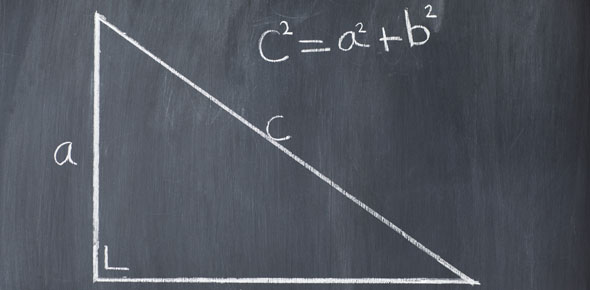Solving Right Angled Triangles

Questions and Answers
- 1.
In a right angle triangle ABC, AB = 6 cm, AC = 10 cm and angle ABC = 90 degrees. The length of side BC is
- A.
11.7 cm
- B.
16 cm
- C.
8 cm
- D.
10 cm
Correct Answer
C. 8 cmExplanation
In a right angle triangle, the side opposite the right angle is called the hypotenuse. In this case, side AB is the hypotenuse. According to the Pythagorean theorem, the square of the length of the hypotenuse is equal to the sum of the squares of the other two sides. So, in this case, 6^2 + BC^2 = 10^2. Simplifying this equation gives BC^2 = 100 - 36 = 64. Taking the square root of both sides, we find that BC = 8 cm. Therefore, the length of side BC is 8 cm.Rate this question:
-
- 2.
In a right angle triangle ABC, AB = 12 m, angle ABC = 90 degrees and angle BAC = 60 degrees. The length of side AC is
- A.
6 cm
- B.
24 cm
- C.
10.4 cm
- D.
16.5 cm
Correct Answer
B. 24 cmExplanation
In a right angle triangle, the side opposite the right angle is called the hypotenuse. In this triangle, angle BAC is 60 degrees, which means it is an equilateral triangle. Therefore, all sides of the triangle are equal. Since AB = 12 m, AC is also equal to 12 m. Hence, the length of side AC is 12 m or 24 cm.Rate this question:
-
- 3.
In a right angle triangle ABC, AB = 12 cm,. BC = 10 cm and angle ABC = 90 degrees. The size of angle ACB is
- A.
39.8 degrees
- B.
56.4 degrees
- C.
33.6 degrees
- D.
50.2 degrees
Correct Answer
D. 50.2 degreesExplanation
In a right angle triangle, the sum of all angles is always 180 degrees. Since angle ABC is given as 90 degrees, the sum of angle ACB and angle BCA must be 90 degrees. Therefore, angle ACB is 90 - angle BCA. Using the Pythagorean theorem, we can find that AC = √(AB^2 + BC^2) = √(12^2 + 10^2) = √(144 + 100) = √244. Using the sine function, sin(ACB) = BC/AC = 10/√244. Taking the inverse sine, we find angle ACB ≈ 50.2 degrees.Rate this question:
-
- 4.
Point B is 5 m south of point A, point C is 8 m east of point B and point D is x m east of point C. If the distance from A to to D is 13 m then the value of x is
- A.
4 m
- B.
9 m
- C.
6m
- D.
8m
Correct Answer
A. 4 mExplanation
Point B is 5 m south of point A, which means that point B is located 5 m below point A. Point C is 8 m east of point B, so point C is located 8 m to the right of point B. Point D is x m east of point C, so point D is located x m to the right of point C. The distance from A to D is 13 m, which means that the total distance from A to C to D is 13 m. Since the distance from A to C is 8 m and the distance from C to D is x m, we can subtract 8 m from 13 m to find that x is equal to 5 m. Therefore, the value of x is 4 m.Rate this question:
-
- 5.
One end of a piece of wire 14 m long is attached to the top of a vertical pole and the other end is attached to the ground at an angle of 70 degrees to the ground. What is the height of the pole?
- A.
4.8 m
- B.
14.9 cm
- C.
13.2 m
- D.
38.5 m
Correct Answer
C. 13.2 mExplanation
The height of the pole can be determined using trigonometry. The wire forms a right triangle with the pole and the ground. The angle between the wire and the ground is given as 70 degrees. We can use the sine function to find the height of the pole. The sine of an angle is equal to the ratio of the opposite side to the hypotenuse. In this case, the opposite side is the height of the pole, the hypotenuse is the length of the wire (14 m), and the angle is 70 degrees. By rearranging the formula, we can solve for the height of the pole, which is approximately 13.2 m.Rate this question:
-
Quiz Review Timeline +
Our quizzes are rigorously reviewed, monitored and continuously updated by our expert board to maintain accuracy, relevance, and timeliness.
-
Current Version
-
Mar 21, 2023Quiz Edited by
ProProfs Editorial Team -
Feb 02, 2014Quiz Created by
Glendavid
 Back to top
Back to top


